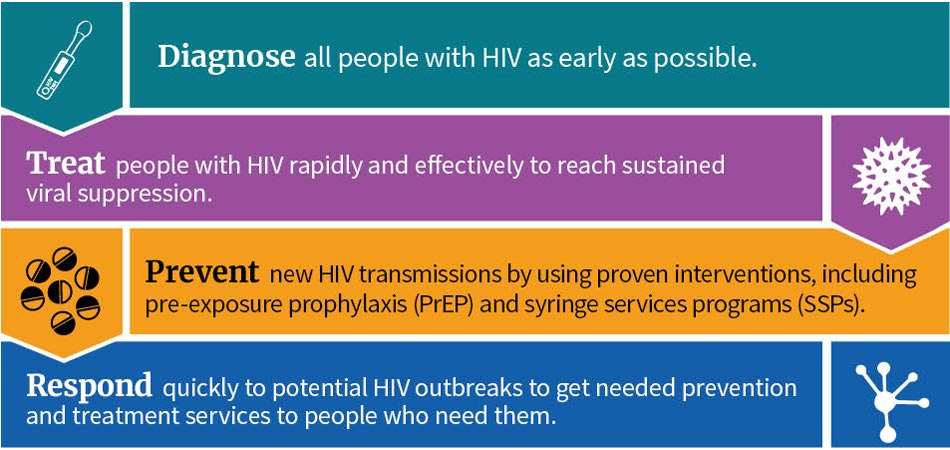Key EHE Strategies
To achieve the goal of reducing new HIV infections in the United States by 90% by 2030, the Ending the HIV Epidemic in the U.S. initiative focuses on four key strategies that, together, can end the HIV epidemic in the U.S.: Diagnose, Treat, Prevent, and Respond.

Diagnose all individuals with HIV as early as possible after infection.

According to CDC, as of 2021, more than 153,000 Americans are unaware they are living with HIV, down from 160,000 when the EHE initiative began in 2019. Early detection coupled with rapid linkage to care is critical and can lead to improved individual and community health outcomes. Improved, more accessible, and routine HIV testing, immediately connecting people with HIV to care services, and connecting those who test negative to appropriate prevention services are important activities supporting this strategy. CDC, HRSA, IHS, SAMHSA and other HHS agencies are working in collaboration with communities to increase local capacity to expand the availability of HIV testing in health centers, emergency departments, STI clinics, substance abuse prevention and treatment programs, mobile units, and community-based organizations and non-traditional settings such as bars, parks, and during community festivals as well as to scale up the availability of HIV self-testing.
Treat people with HIV rapidly and effectively to reach sustained viral suppression.

Current HIV treatment guidelines recommend all people with HIV begin treatment with HIV medicine (called antiretroviral therapy or ART) as soon as possible after receiving a diagnosis. If taken as prescribed, HIV medicine reduces the amount of HIV in the blood (also called the viral load) to a very low level. This is called viral suppression, defined as having less than 200 copies of HIV per milliliter of blood. HIV medicine can also make the viral load so low that a standard lab test can’t detect it. This is called having an undetectable level viral load. Today, people with HIV who take HIV medicine as prescribed and get and keep an undetectable viral load can live long and healthy lives and will not transmit HIV to an HIV-negative partner through sex. This is sometimes referred to as “Undetectable = Untransmittable” or U=U. Increasing the proportion of people with HIV who are virally suppressed or have an undetectable viral load is a key strategy to prevent new HIV transmissions. According to the most recent CDC estimates, as of 2021, 65.9% of all people with diagnosed HIV in the U.S. were virally suppressed, up from 63.1% when the EHE initiative began. Using innovative new models of service delivery, including building on the success of the Ryan White HIV/AIDS Program, the EHE initiative seeks to increase viral suppression to 90 percent nationally by 2030. Achieving this target requires:
- Promptly linking individuals newly diagnosed with HIV to care and treatment, including through rapid start treatment programs;
- Finding innovative and effective ways to re-engage the estimated 250,000 individuals who are aware of their infection but not receiving HIV care and treatment; and
- Supporting those already in care who have not yet achieved viral suppression to achieve control of the virus.
HHS agencies are working with healthcare providers, Ryan White clinics and health centers, health departments, and other partners to expand capacity, strengthen systems, establish new programs and services, and forge new partnerships to tailor and implement these approaches as appropriate in their communities.
Prevent new HIV transmissions by using proven interventions, including pre-exposure prophylaxis (PrEP) and syringe services programs (SSPs).

Since the HIV epidemic affects communities differently, plans developed locally with community member input guide the scale-up of proven prevention interventions and strategies. This increases the access to and availability of PrEP and SSPs in the communities where these services are needed most.
PrEP is HIV medicine taken by people who don’t have HIV to reduce the risk of getting HIV when taken as prescribed. However, of the estimated 1.2 million Americans at substantial risk for HIV who could benefit from PrEP, as of 2022, slightly more than a third (36%) were using it. That’s up from 23% when the EHE initiative began. HHS agencies are supporting states and local communities to implement strategies to increase awareness of, access to, and use of PrEP—especially among African American and Latino gay and bisexual men, African American women, and other populations disproportionately affected by HIV. This includes expanding telePrEP and same-day PrEP starts, engaging pharmacies in PrEP services, and training more clinicians about PrEP. In addition, health centers are expanding PrEP services.
SSPs are another effective component of a comprehensive, integrated approach to HIV prevention for people who inject drugs. More than 30 years of research has proven SSPs are a safe, effective, cost-saving intervention that does not contribute to illegal drug use or crime. SSPs play an important role in reducing the transmission of viral hepatitis, HIV, and other infections. Comprehensive SSPs dramatically reduce HIV risk and can provide an entry point for a range of services to help stop drug use, overdose deaths, and infectious diseases. CDC is working with SAMHSA to increase access to and use of comprehensive SSPs and working with local communities to implement SSPs where they are needed and permitted by state and local laws.
Respond quickly to potential HIV outbreaks to get needed prevention and treatment services to people who need them.

Real-time response systems are key to ending the HIV epidemic in the United States. Cutting-edge public health strategies, including new epidemiological approaches, help quickly identify communities experiencing rapid HIV transmission. Once detected, local public health officials, community-based organizations, and other partners can quickly implement strategies to address gaps in HIV prevention and treatment services to stop ongoing transmission, making sure that tailored HIV services reach the people and places that need them. HHS agencies are working with impacted communities to ensure they have the additional expertise, technology, personnel, and prevention resources to follow up on all HIV cases and to intervene to stop chains of transmission, and to get those affected into appropriate prevention services or care and treatment.
In implementing these strategies, the initiative's major areas of action include:
- Increasing investments in geographic areas where the most HIV diagnoses occur through existing programs such as the Ryan White HIV/AIDS Program as well as establishing new programs through community health centers to provide outreach, HIV testing, PrEP, and care coordination.
- Using data to identify where HIV is spreading most rapidly and guide decision-making to address prevention, care, and treatment needs at the local level.
- Supporting the priority jurisdictions to establish and maintain local teams committed to the success of the Initiative who work with the community to design, implement, monitor, and revise locally developed, locally tailored plans that expand and improve HIV prevention and treatment services and engage new partners to reach populations in need of those services.
